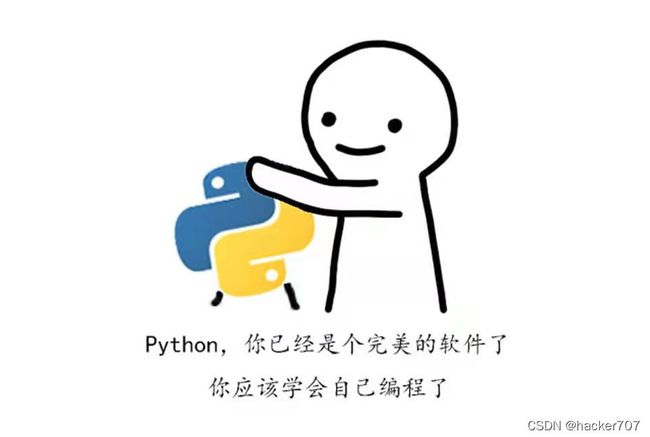BeautifulSoup的基本使用
✅作者简介:大家好我是hacker707,大家可以叫我hacker
个人主页:hacker707的csdn博客
系列专栏:python爬虫
如果觉得博主的文章还不错的话,请三连支持一下博主哦
bs4
- bs4的安装
-
- bs4的快速入门
- 解析器的比较(了解即可)
- 对象种类
-
- bs4的简单使用
-
- 遍历文档树
-
- 案例练习
- 思路
- 代码实现
bs4的安装
要使用BeautifulSoup4需要先安装lxml,再安装bs4
pip install lxml
pip install bs4
使用方法:
from bs4 import BeautifulSoup
lxml和bs4对比学习
from lxml import etree
tree = etree.HTML(html)
tree.xpath()
from bs4 import BeautifulSoup
soup = BeautifulSoup(html_doc, 'lxml')
注意事项:
创建soup对象时如果不传’lxml’或者features="lxml"会出现以下警告

bs4的快速入门
解析器的比较(了解即可)
| 解析器 | 用法 | 优点 | 缺点 |
|---|---|---|---|
| python标准库 | BeautifulSoup(markup,‘html.parser’) | python标准库,执行速度适中 | (在python2.7.3或3.2.2之前的版本中)文档容错能力差 |
| lxml的HTML解析器 | BeautifulSoup(markup,‘lxml’) | 速度快,文档容错能力强 | 需要安装c语言库 |
| lxml的XML解析器 | BeautifulSoup(markup,‘lxml-xml’)或者BeautifulSoup(markup,‘xml’) | 速度快,唯一支持XML的解析器 | 需要安装c语言库 |
| html5lib | BeautifulSoup(markup,‘html5lib’) | 最好的容错性,以浏览器的方式解析文档,生成HTML5格式的文档 | 速度慢,不依赖外部扩展 |
对象种类
Tag:标签
BeautifulSoup:bs对象
NavigableString:可导航的字符串
Comment:注释
from bs4 import BeautifulSoup
# 创建模拟HTML代码的字符串
html_doc = """
The Dormouse's story
The Dormouse's story
Once upon a time there were three little sisters; and their names were
Elsie,
Lacie and
Tillie;
and they lived at the bottom of a well.
...
"""
# 创建soup对象
soup = BeautifulSoup(html_doc, 'lxml')
print(type(soup.title)) # bs4的简单使用
获取标签内容
from bs4 import BeautifulSoup
# 创建模拟HTML代码的字符串
html_doc = """
The Dormouse's story
The Dormouse's story
Once upon a time there were three little sisters; and their names were
Elsie,
Lacie and
Tillie;
and they lived at the bottom of a well.
...
"""
# 创建soup对象
soup = BeautifulSoup(html_doc, 'lxml')
print('head标签内容:\n', soup.head) # 打印head标签
print('body标签内容:\n', soup.body) # 打印body标签
print('html标签内容:\n', soup.html) # 打印html标签
print('p标签内容:\n', soup.p) # 打印p标签
✅注意:在打印p标签对应的代码时,可以发现只打印了第一个p标签内容,这时我们可以通过find_all来获取p标签全部内容
print('p标签内容:\n', soup.find_all('p'))
✅这里需要注意使用find_all里面必须传入的是字符串
获取标签名字
通过name属性获取标签名字
from bs4 import BeautifulSoup
# 创建模拟HTML代码的字符串
html_doc = """
The Dormouse's story
The Dormouse's story
Once upon a time there were three little sisters; and their names were
Elsie,
Lacie and
Tillie;
and they lived at the bottom of a well.
...
"""
# 创建soup对象
soup = BeautifulSoup(html_doc, 'lxml')
print('head标签名字:\n', soup.head.name) # 打印head标签名字
print('body标签名字:\n', soup.body.name) # 打印body标签名字
print('html标签名字:\n', soup.html.name) # 打印html标签名字
print('p标签名字:\n', soup.find_all('p').name) # 打印p标签名字
✅如果要找到两个标签的内容,需要传入列表过滤器,而不是字符串过滤器
使用字符串过滤器获取多个标签内容会返回空列表
print(soup.find_all('title', 'p'))
[]
需要使用列表过滤器获取多个标签内容
print(soup.find_all(['title', 'p']))
[<title>The Dormouse's story, The Dormouse'
s story</b></p>, <p class="story">Once upon a time there were three little sisters; and their names were
<a class="sister" href="http://example.com/elsie" id="link1">Elsie</a>,
<a class="sister" href="http://example.com/lacie" id="link2">Lacie</a> and
<a class="sister" href="http://example.com/tillie" id="link3">Tillie</a>;
and they lived at the bottom of a well.</p>, <p class="story">...</p>]
获取a标签的href属性值
from bs4 import BeautifulSoup
# 创建模拟HTML代码的字符串
html_doc = """
The Dormouse's story
The Dormouse's story
Once upon a time there were three little sisters; and their names were
Elsie,
Lacie and
Tillie;
and they lived at the bottom of a well.
...
"""
# 创建soup对象
soup = BeautifulSoup(html_doc, 'lxml')
a_list = soup.find_all('a')
# 遍历列表取属性值
for a in a_list:
# 第一种方法通过get去获取href属性值(没有找到返回None)
print(a.get('href'))
# 第二种方法先通过attrs获取所有属性值,再提取出你想要的属性值
print(a.attrs['href'])
# 第三种方法获取没有的属性值会报错
print(a['href'])
✅扩展:使用prettify()美化 让节点层级关系更加明显 方便分析
print(soup.prettify())
不使用prettify时的代码
<html><head><title>The Dormouse's story</title></head>
<body>
<p class="title"><b>The Dormouse's story</b></p>
<p class="story">Once upon a time there were three little sisters; and their names were
<a class="sister" href="http://example.com/elsie" id="link1">Elsie</a>,
<a class="sister" href="http://example.com/lacie" id="link2">Lacie</a> and
<a class="sister" href="http://example.com/tillie" id="link3">Tillie</a>;
and they lived at the bottom of a well.</p>
<p class="story">...</p>
</body></html>
使用prettify时的代码
<html>
<head>
<title>
The Dormouse's story
</title>
</head>
<body>
<p class="title">
<b>
The Dormouse's story
</b>
</p>
<p class="story">
Once upon a time there were three little sisters; and their names were
<a class="sister" href="http://example.com/elsie" id="link1">
Elsie
</a>
,
<a class="sister" href="http://example.com/lacie" id="link2">
Lacie
</a>
and
<a class="sister" href="http://example.com/tillie" id="link3">
Tillie
</a>
;
and they lived at the bottom of a well.
</p>
<p class="story">
...
</p>
</body>
</html>
遍历文档树
from bs4 import BeautifulSoup
# 创建模拟HTML代码的字符串
html_doc = """
The Dormouse's story
The Dormouse's story
Once upon a time there were three little sisters; and their names were
Elsie,
Lacie and
Tillie;
and they lived at the bottom of a well.
...
"""
soup = BeautifulSoup(html_doc, 'lxml')
head = soup.head
# contents返回的是所有子节点的列表 [The Dormouse's story ]
print(head.contents)
# children返回的是一个子节点的迭代器 案例练习
获取所有职位名称
html = """
职位名称
职位类别
人数
地点
发布时间
22989-金融云区块链高级研发工程师(深圳)
技术类
1
深圳
2017-11-25
22989-金融云高级后台开发
技术类
2
深圳
2017-11-25
SNG16-腾讯音乐运营开发工程师(深圳)
技术类
2
深圳
2017-11-25
SNG16-腾讯音乐业务运维工程师(深圳)
技术类
1
深圳
2017-11-25
TEG03-高级研发工程师(深圳)
技术类
1
深圳
2017-11-24
TEG03-高级图像算法研发工程师(深圳)
技术类
1
深圳
2017-11-24
TEG11-高级AI开发工程师(深圳)
技术类
4
深圳
2017-11-24
15851-后台开发工程师
技术类
1
深圳
2017-11-24
15851-后台开发工程师
技术类
1
深圳
2017-11-24
SNG11-高级业务运维工程师(深圳)
技术类
1
深圳
2017-11-24
"""
思路
不难看出想要的数据在tr节点的a标签里,只需要遍历所有的tr节点,从遍历出来的tr节点取a标签里面的文本数据
代码实现
from bs4 import BeautifulSoup
html = """
职位名称
职位类别
人数
地点
发布时间
22989-金融云区块链高级研发工程师(深圳)
技术类
1
深圳
2017-11-25
22989-金融云高级后台开发
技术类
2
深圳
2017-11-25
SNG16-腾讯音乐运营开发工程师(深圳)
技术类
2
深圳
2017-11-25
SNG16-腾讯音乐业务运维工程师(深圳)
技术类
1
深圳
2017-11-25
TEG03-高级研发工程师(深圳)
技术类
1
深圳
2017-11-24
TEG03-高级图像算法研发工程师(深圳)
技术类
1
深圳
2017-11-24
TEG11-高级AI开发工程师(深圳)
技术类
4
深圳
2017-11-24
15851-后台开发工程师
技术类
1
深圳
2017-11-24
15851-后台开发工程师
技术类
1
深圳
2017-11-24
SNG11-高级业务运维工程师(深圳)
技术类
1
深圳
2017-11-24
"""
# 创建soup对象
soup = BeautifulSoup(html, 'lxml')
# 使用find_all()找到所有的tr节点(经过观察第一个tr节点为表头,忽略不计)
tr_list = soup.find_all('tr')[1:]
# 遍历tr_list取a标签里的文本数据
for tr in tr_list:
a_list = tr.find_all('a')
print(a_list[0].string)
运行结果如下:
22989-金融云区块链高级研发工程师(深圳)
22989-金融云高级后台开发
SNG16-腾讯音乐运营开发工程师(深圳)
SNG16-腾讯音乐业务运维工程师(深圳)
TEG03-高级研发工程师(深圳)
TEG03-高级图像算法研发工程师(深圳)
TEG11-高级AI开发工程师(深圳)
15851-后台开发工程师
15851-后台开发工程师
SNG11-高级业务运维工程师(深圳)
以上就是bs4的基本使用,如果有改进的建议,欢迎在评论区留言奥~

